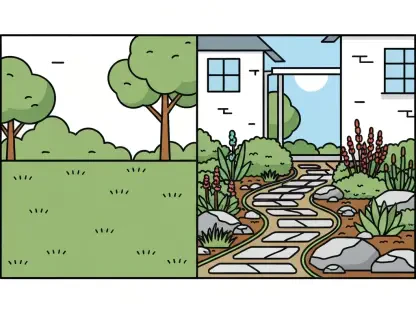Architecture in Tasmania has always significantly contributed to cultural and community development within the region. The Tasmanian Architecture Awards of 2025 marked a pivotal moment in acknowledging the state’s most outstanding architectural achievements across multiple dimensions, from residential dwellings to public spaces. This prestigious event shines a light on how architectural design can transcend mere structural demands, becoming a medium through which human interaction with the environment is enhanced. Honorees at the awards demonstrated both groundbreaking innovation and a deep-seated commitment to sustainability, pointing toward a future where architectural creativity intertwines with ecological mindfulness to meet societal needs and aspirations.
Achievements in Residential Architecture
Designing Spaces that Blend with Nature
One of the foremost highlights of the Tasmanian Architecture Awards was the residential project called Nebraska, crafted by Lara Maeseele. Located on the picturesque Bruny Island, Nebraska deftly manages to offer expansive living spaces while maintaining a small physical footprint, winning the category for Residential Architecture – Houses (New). The jury commended its design prowess, emphasizing its harmonious merger with the natural landscape and its ability to provide a serene retreat. Descriptions praised it as a “beautiful and intelligent” solution within a challenging design brief. This encapsulates a broader architectural narrative—where thoughtful design is not merely aesthetic but serves as a tool to deepen human connections to their surroundings, ultimately enhancing both charm and functionality.
Revitalizing Heritage with Modern Touches
In the realm of transforming existing residential spaces, Jordan House by Preston Lane was celebrated under the category of Residential Architecture – Houses (Alterations and Additions). This project captivated the jury with its seamless blend of old and new, skillfully extending a historical home without overshadowing its original charm. The architects achieved a delicate balance by introducing luminous, modern extensions while drawing clear boundaries between the historic and contemporary sections. This arrangement invites inhabitants to savor the full historical context of their residence. Such endeavors echo a growing recognition of preserving cultural heritage and history through architecture, ensuring that the past remains an integral part of modern living.
Innovations in Commercial and Public Architecture
Sustainable Materials Leading the Way
The commercial architecture category saw commendable innovations like Tolpuddle Tasting Room by Tanner Architects and The St Lukes Building by Terroir. The Tolpuddle project not only impressed with its sophisticated design that calibrates beautifully with its agricultural surroundings but also with its economic ingenuity, achieving remarkable outcomes on a limited budget. This approach was recognized in the Sustainable Architecture category, underscoring the importance of creativity within constraints. Meanwhile, The St Lukes Building set a new benchmark by pioneering the use of local plantation timber in mass timber construction. This forward-thinking endeavor highlights emerging architectural trends focused on sustainability, showcasing a deep commitment to using renewable resources and emphasizing environmental stewardship.
Transforming Public Spaces for Community Benefit
Significant architectural strides were made in public spaces, with the Glenorchy Ambulance Station by Morrison & Breytenbach Architects emerging as a noteworthy project. This endeavor demonstrated how public facilities could be revitalized to better serve communities through innovative design solutions. By reimagining traditional public architecture, such projects can effectively respond to ever-evolving urban needs, resulting in spaces that promote community well-being and engagement. The ongoing focus on enhancing public infrastructure illustrates architecture’s capacity to act as a catalyst for social good, creating environments that are both functional and welcoming to those they serve.
Advances in Educational and Interior Architecture
Evolving Educational Spaces for Modern Pedagogies
Educational buildings took center stage with the Alma Street Childcare Centre by 1+2 Architecture and The Shed, University of Tasmania by Wardle receiving accolades for their innovative contributions. These designs addressed the pressing need for educational spaces that support contemporary teaching methods while fostering environments conducive to learning and growth. Both projects exhibited a keen sensitivity to current educational paradigms, offering spaces that encourage exploration and collaboration among students. Such advancements signify a shift in educational architecture that goes beyond traditional settings, aiming to reflect and cater to the holistic development of future generations.
Interior Design Fostering Social Inclusion
In the realm of interior design, projects such as The Shed at the University of Tasmania and the Glenorchy Child and Family Learning Centre stood out for their emphasis on promoting engagement and practicality. Interior designs that support social inclusion, like those of Isabel and Elsie, aimed at aiding women and children recovering from homelessness, demonstrate an emergent architectural focus. These projects highlight architecture’s potential to not only provide shelter but also foster recovery and holistic well-being. By prioritizing trauma-informed design principles, architects can create rehabilitative environments that contribute positively to individuals and communities alike.
Honorary Recognitions and Broader Impact
Celebrating Emergent Talent
Within the ceremony, attention was also dedicated to emerging talents in the architectural sector. Recognitions such as the Emerging Architect Prize awarded to Liz Walsh and Alex Nielsen of So. Architecture serve as a testament to the fresh perspectives and inventive approaches shaping the industry. Additionally, John Ancher was honored with the President’s Prize for his outstanding contributions to Tasmanian architecture. Such accolades underscore a deeper appreciation for visionary architects whose work significantly enriches the region’s architectural landscape and culture.
Addressing Societal Challenges Through Architecture
Architecture in Tasmania has long played a vital role in fostering cultural and community growth within the region. The 2025 Tasmanian Architecture Awards were pivotal in celebrating the state’s most exceptional architectural creations, spanning residential homes to public spaces. This esteemed event highlighted how architecture can transcend simple structural necessities, evolving into a medium that enriches human interaction with the environment. The award recipients showcased groundbreaking innovation and strong dedication to sustainability, illuminating a future where architectural imagination intertwines with ecological awareness to fulfill societal demands and desires. As Tasmanian architects continue to push the boundaries, they promote designs that not only meet practical needs but also elevate the community’s relationship with nature. By integrating sustainability into their projects, architects contribute to a future built on harmony between modern technology and the natural world, enriching lives and driving community progress.









